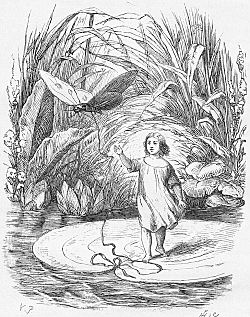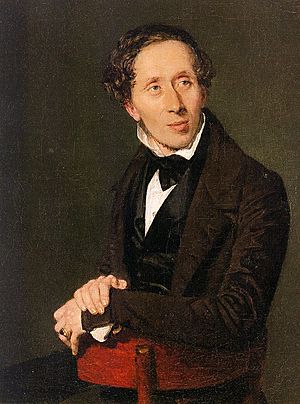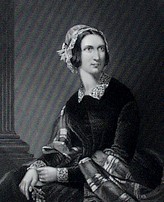Thumbelina facts for kids
Quick facts for kids "Thumbelina" |
|
|---|---|

Illustration by Vilhelm Pedersen,
Andersen's first illustrator |
|
| Author | Hans Christian Andersen |
| Original title | Tommelise |
| Translator | Mary Howitt |
| Country | Denmark |
| Language | Danish |
| Genre(s) | Fairy tale |
| Published in | Fairy Tales Told for Children. First Collection. Second Booklet. 1835. (Eventyr, fortalte for Børn. Første Samling. Andet Hefte. 1835.) |
| Publication type | Fairy tale collection |
| Publisher | C. A. Reitzel |
| Media type | |
| Publication date | 16 December 1835 |
| Published in English | 1846 |
| Preceded by | Little Ida's Flowers |
| Followed by | The Naughty Boy |
"Thumbelina" (Danish: Tommelise) is a fairy tale by Hans Christian Andersen. The tale was first printed by C. A. Reitzel on 16 December 1835 in Copenhagen, Denmark. "Thumbelina" is about a tiny girl. She has several adventures with a toad, a mole, a field mouse, and other creatures of field and forest. At the end, she meets and falls in love with a flower-fairy prince just her size.
"Thumbelina" was one of nine fairy tales Andersen printed between 1835 and 1837 in a series of three booklets. These booklets were called Fairy Tales Told for Children. "Thumbelina" appeared in the second booklet with "The Naughty Boy" and "The Traveling Companion". The first booklet included "The Tinderbox", "Great Claus and Little Claus", "The Princess and the Pea", and "Little Ida's Flowers". The third booklet was printed in 1837. Only two tales, "The Little Mermaid" and "The Emperor's New Clothes", appeared in the third and final booklet.
"Thumbelina" is completely Andersen's invention. He did however know tales about tiny people such as "Tom Thumb" and the six-inch tall Lilliputians in Gulliver's Travels. He may have taken some inspiration from these tales. Andersen's tales were not liked by the Danish critics. They did not like their casual style and their lack of morals. One critic liked "Thumbelina". He called it "delightful". The tale has been adapted to an animated movie and a live-action television programme.
Plot
A woman wants a baby. She asks a witch to help her. The witch gives the woman a barleycorn. She tells the woman to plant it, and wait for what will happen. The barleycorn is planted, and a flower grows. When the woman kisses the flower, it pops open to reveal tiny Thumbelina.
One night, Thumbelina is asleep in her walnut-shell cradle. She is carried off by a toad who hops through an open window. The toad wants the tiny girl as a bride for her son. She puts Thumbelina on a lily pad for safekeeping. Thumbelina escapes the toad with the help of friendly fish and a white butterfly. She floats away on the lily pad.
She is suddenly snatched and carried away by a cockchafer (beetle). The beetle's friends are proud and arrogant. Thumbelina is not of their social class. They take a dislike to her at once. The beetle drops her without a second thought, and flies away.
Thumbelina lives alone as best she can in the fields. When winter comes, she needs to find a place to live. She is finally given a home by an old field mouse. Thumbelina thanks the mouse by taking care of her little house.
The mouse thinks Thumbelina should marry her neighbor, a smart and well-to-do mole. Thumbelina finds the idea of being married to such a creature hateful. After all, he spends all of his days underground and never sees the sun or sky.
The field mouse does not listen to Thumbelina's protests. She continues to urge the marriage. At the last minute, Thumbelina flies away with a swallow to a far, sunny land. Thumbelina brought the swallow back to health during the winter. They have been friends ever since.
The swallow carries Thumbelina to a sunny land. In a field of flowers, Thumbelina meets a tiny flower-fairy prince just her size and to her liking. They wed. Her husband gives her a pair of wings so she can fly with him on his travels from flower to flower. She is given a new name, Maia.
In the last page of the story, the swallow has flown to a poet's window, and tells him the complete story of Thumbelina.
Note: Mary Howitt was the first to translate the story into English. She disliked the encounter with the witch. In her translation, she starts the tale with a beggar woman giving a peasant's wife a barleycorn in exchange for food. Once the barleycorn is planted, tiny Thumbelina (Tommelise) emerges from its flower.
Background
Hans Christian Andersen was born in Odense, Denmark on 2 April 1805. His father was Hans Andersen, a shoemaker. His mother was Anne Marie Andersdatter, a laundress. Andersen was an only and a spoiled child. He shared a love of books with his father. His father read him The Arabian Nights and the fables of Jean de la Fontaine. Together, they built panoramas, pop-up pictures, and toy theatres. Father and son took long walks into the countryside.
Andersen's father died in 1816. From then on, Andersen was on his own. Andersen was a tall, thin boy who was bullied by other boys. He wanted to escape them, and his poor, illiterate mother. He advertised his artistic talents to the middle class of Odense. He sang and danced in their homes. On 4 September 1819, the fourteen-year-old Andersen left Odense for Copenhagen with gifts of money he had received from his neighbors. He carried a letter of reference to the ballerina Madame Schall, and had dreams of becoming a poet, a ballet dancer, or an actor.
After three years in Copenhagen without someone to support him, Andersen finally found an interested gentleman in Jonas Collin, the director of the Royal Theatre. Collin believed in the boy's talents. He managed to have the king send Andersen to a grammar school in Slagelse, a country town in west Zealand. He thought Andersen would continue his education at Copenhagen University at the right time.
At Slagelse, Andersen was taught by the short, fat, balding thirty-five-year-old Simon Meisling. This man was interested in Ancient Greece and Rome, and had translated Virgil's Aeneid. Andersen was not the brightest student in his class, and Meisling gave Andersen his sharp disapproval. "You're a stupid boy who will never make it," Meisling told him. Meisling is believed to be the model for the learned mole in "Thumbelina".
Fairy tale and folklore researchers Iona and Peter Opie believe that "Thumbelina" is a "distant tribute" to Andersen's friend, Henriette Wulff, the small, delicate, handicapped daughter of the Danish translator of Shakespeare. She loved Andersen as Thumbelina loves the swallow; however, there is no written evidence to support the "distant tribute" theory.
English translations
Mary Howitt was the first to translate "Tommelise" into English. She printed it in 1846 as "Thumbelina" in Wonderful Stories for Children. However, she did not approve of the opening scene with the witch. Instead, she had the childless woman provide bread and milk to a hungry beggar woman. The childless woman was then rewarded with a barleycorn.
Charles Boner also translated the tale in 1846 as "Little Ellie". Madame de Chatelain called the tiny child 'Little Totty' in her 1852 translation. The editor of The Child's Own Book (1853) called the child throughout, 'Little Maja'. H. W. Dulcken's widely printed volumes of Andersen's tales appeared in 1864 and 1866. Mrs. H. B. Paulli translated the name as 'Little Tiny' in the late-nineteenth century.
In the twentieth century, Erik Christian Haugaard translated the name as 'Inchelina' in 1974. Jeffrey and Diane Crone Frank translated the name as 'Thumbelisa' in 2005. Modern English translations of "Thumbelina" are found in the six-volume complete edition of Andersen's tales from the 1940s by Jean Hersholt. Erik Christian Haugaard’s translation of the complete tales was published in 1974.
Adaptations
Thumbelina has been adapted to different media. The earliest animated version of the tale is a silent, black-and-white release by director Herbert M. Dawley in 1924. Lotte Reiniger released a 10-minute movie adaptation in 1954 featuring her "silhouette" puppets.
Don Bluth's full-length animated movie, Thumblina may be one of the best known versions. The story was also adapted to the live-action television program, Faerie Tale Theatre. This production starred Carrie Fisher. The direct-to-DVD animated movie, Barbie Presents Thumbelina was released in 2009. Russia and Japan have also released animated productions.
See also
 In Spanish: Pulgarcita para niños
In Spanish: Pulgarcita para niños



